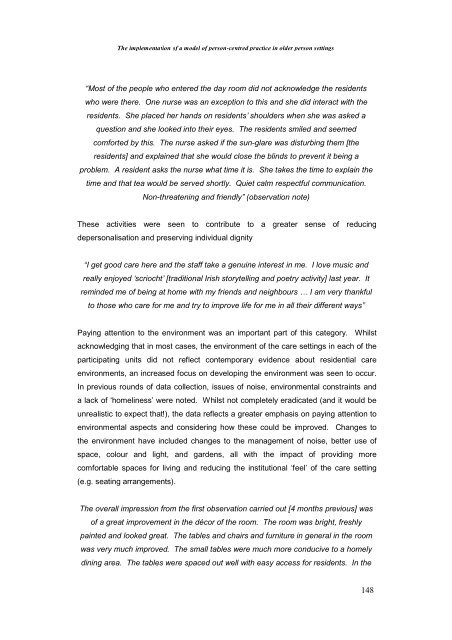The Implementation of a Model of Person-Centred Practice In Older ...
The Implementation of a Model of Person-Centred Practice In Older ...
The Implementation of a Model of Person-Centred Practice In Older ...
Create successful ePaper yourself
Turn your PDF publications into a flip-book with our unique Google optimized e-Paper software.
<strong>The</strong> implementation <strong>of</strong> a model <strong>of</strong> person-centred practice in older person settings<br />
“Most <strong>of</strong> the people who entered the day room did not acknowledge the residents<br />
who were there. One nurse was an exception to this and she did interact with the<br />
residents. She placed her hands on residents’ shoulders when she was asked a<br />
question and she looked into their eyes. <strong>The</strong> residents smiled and seemed<br />
comforted by this. <strong>The</strong> nurse asked if the sun-glare was disturbing them [the<br />
residents] and explained that she would close the blinds to prevent it being a<br />
problem. A resident asks the nurse what time it is. She takes the time to explain the<br />
time and that tea would be served shortly. Quiet calm respectful communication.<br />
Non-threatening and friendly” (observation note)<br />
<strong>The</strong>se activities were seen to contribute to a greater sense <strong>of</strong> reducing<br />
depersonalisation and preserving individual dignity<br />
“I get good care here and the staff take a genuine interest in me. I love music and<br />
really enjoyed ‘scriocht’ [traditional Irish storytelling and poetry activity] last year. It<br />
reminded me <strong>of</strong> being at home with my friends and neighbours … I am very thankful<br />
to those who care for me and try to improve life for me in all their different ways”<br />
Paying attention to the environment was an important part <strong>of</strong> this category. Whilst<br />
acknowledging that in most cases, the environment <strong>of</strong> the care settings in each <strong>of</strong> the<br />
participating units did not reflect contemporary evidence about residential care<br />
environments, an increased focus on developing the environment was seen to occur.<br />
<strong>In</strong> previous rounds <strong>of</strong> data collection, issues <strong>of</strong> noise, environmental constraints and<br />
a lack <strong>of</strong> ‘homeliness’ were noted. Whilst not completely eradicated (and it would be<br />
unrealistic to expect that!), the data reflects a greater emphasis on paying attention to<br />
environmental aspects and considering how these could be improved. Changes to<br />
the environment have included changes to the management <strong>of</strong> noise, better use <strong>of</strong><br />
space, colour and light, and gardens, all with the impact <strong>of</strong> providing more<br />
comfortable spaces for living and reducing the institutional ‘feel’ <strong>of</strong> the care setting<br />
(e.g. seating arrangements).<br />
<strong>The</strong> overall impression from the first observation carried out [4 months previous] was<br />
<strong>of</strong> a great improvement in the décor <strong>of</strong> the room. <strong>The</strong> room was bright, freshly<br />
painted and looked great. <strong>The</strong> tables and chairs and furniture in general in the room<br />
was very much improved. <strong>The</strong> small tables were much more conducive to a homely<br />
dining area. <strong>The</strong> tables were spaced out well with easy access for residents. <strong>In</strong> the<br />
148
















